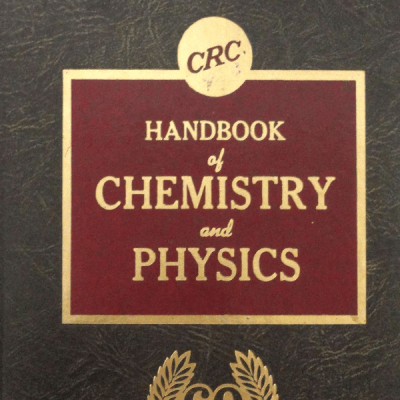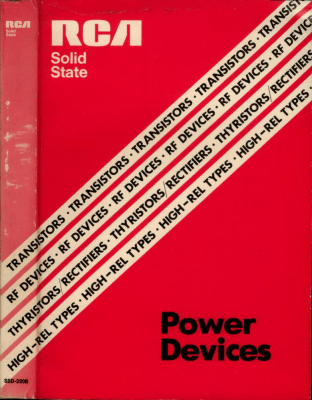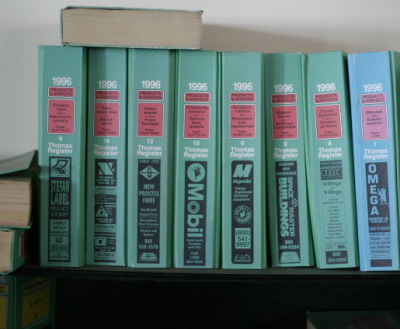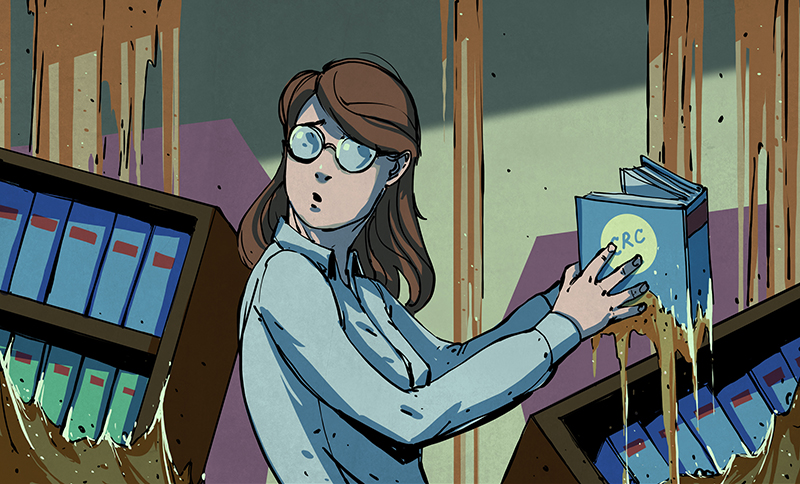Quick. What’s the difference in conductivity between silver and copper? Today, that’s easy to find out. You just ask Google (maybe even out loud if you have a phone handy). But it wasn’t that long ago that you needed another option. Before the Internet age, a big part of being “that guy” (or gal) was knowing where to go to find things. You had to be a master of the library’s reference section, know what might be in an encyclopedia or an almanac.
However if you were a hardcore math, science, or engineering geek you probably had, at least, one edition of CRC handbooks. Today, we usually think of CRC as cyclic redundancy check, but back then it was the Chemical Rubber Company.
The Chemical Rubber Company dates back to 1903 when brothers Arthur, Leo, and Emanuel Friedman were selling rubber lab aprons in Cleveland, Ohio (Arthur, apparently, had been in a similar business from 1900). In 1913, the brothers offered a short (116-page) booklet called the Rubber Handbook free with the purchase of a dozen aprons.
 The Rubber Handbook grew into the Chemical Rubber Companys’s big book, the CRC Handbook of Chemistry and Physics. You can still actually buy several of the CRC handbooks, and the big one is even online now (although you need a subscription). These used to be staples on engineer’s desks along with databooks, IC Masters, EE Masters, and maybe even a big green set of Thomas’ Register books.
The Rubber Handbook grew into the Chemical Rubber Companys’s big book, the CRC Handbook of Chemistry and Physics. You can still actually buy several of the CRC handbooks, and the big one is even online now (although you need a subscription). These used to be staples on engineer’s desks along with databooks, IC Masters, EE Masters, and maybe even a big green set of Thomas’ Register books.
What’s Inside?
Not everything in the big CRC Handbook is useful to people like us. After all, some of it is pretty esoteric chemistry. But if you need to know things like conductivity of copper or the melting point of aluminum oxide, you are in business. What’s the resistivity of graphite? There’s a whole paper on that topic that answers the question in detail, depending on exactly what kind of graphite you have.
In fact, the property of solids section is one I have used quite a bit in some of my previous jobs. There are dielectric constants and information on secondary electron emission that used to be important to me. Modern versions even have information on superconductors.
Section 17 has a glut of mathematical tables. You can find constants, of course, but also tables for algebra, geometry, trig, and calculus. If you need to work out a series or a transform (like a Fourier transform), the book covers that too. There is, by the way, an entire CRC handbook just for math. That was another staple in my library for many years.

Even though you need a subscription to view the contents of the book, you can see the table of contents online to get an idea of what it contains. Keep in mind this was just one of the books you needed to be an in-the-know engineer in the old days. That led to a problem: what to do with all those books (and magazines)? Many people switched over to microfiche — cards with 16mm microfilm images of book pages you could read (and sometimes print) with a special machine.
I Come to Bury Books…
You don’t see these books as often as you once did. Partially that’s because you can get them online or on eBook readers now. Mostly, though, I think it is because Google can answer most of the questions you’d ask of a book like this. Granted, you have a pretty good idea the CRC Handbook is correct and any answer you find on Google, you need to make a judgment on how likely it is to be correct. Still, there are plenty of reputable sources on the Internet that can replace most of the information in these books. Encyclopedias have suffered a similar fate.

They aren’t cheap either unless you can find an old used one. A quick check on Amazon told me that the price of a new or electronic copy was about $150 and used ones weren’t much less. I’m not above paying that for a book, but it needs to earn its space on my bookshelf at that price point.
Maybe we are better off without the CRC Handbooks, the IC Masters, and the other reference books? I can’t argue that I want to go back. But there is one thing I miss. Skimming through any of these books were likely to take you down some rabbit holes, some of which might turn out to be unexpectedly interesting or significant.
I can’t count the times that something has come up, and I’ve thought, “Oh yeah, I saw something about that the other day…” With the Internet, you tend to be focused. You ask for a result, and you are very unlikely to glimpse something almost entirely unrelated that might come in handy later. I’ve often had the same thought about encyclopedias. While Wikipedia is great (at least, often), you’ll never find yourself looking up, say, elasticity, and wind up reading about elaterium, a drug someone makes from the squirting cucumber plant (which is something else I had to look up).
Get it While You Can
 Even an old copy of a CRC handbook can be pretty useful. Most of the data in them doesn’t change from year to year, although new things get added and some things get rearranged. I’m sure there are cases where some scientific development caused data to change, but there shouldn’t be very many of those changes. If you aren’t sure, check out the library–they still have one, most likely. You can often find CRCs at used bookstores too, particularly around universities.
Even an old copy of a CRC handbook can be pretty useful. Most of the data in them doesn’t change from year to year, although new things get added and some things get rearranged. I’m sure there are cases where some scientific development caused data to change, but there shouldn’t be very many of those changes. If you aren’t sure, check out the library–they still have one, most likely. You can often find CRCs at used bookstores too, particularly around universities.
Some of the other old reference books are probably a little more dubious in value. An IC Master, now, would be horribly out of date as would most vendor’s printed data books. The same goes for old EE Masters, Thomas’ Registers, and the like. Companies come and go. Chips and components come and go. But math and physical properties don’t change that much.
Earlier, I wrote about how we need to adapt to the new reality of having Internet information at your fingertips. The printed reference book is a casualty of that movement, and I doubt it will come back. However, just because it has been superseded doesn’t mean you can’t learn something from it.
Photo Credits:
Thomas Register photo: [sixmilliondollardan] CC-2.0
Microfiche photo: [I, Ianare] CC BY-SA 2.5, via Wikimedia Commons
















While horribly out of date for most new designs, old IC databooks are sometimes the only place one can find complete (or any) information on older parts, which can be quite valuable for reverse engineering and maintaining older equipment. And, there are whole fields of technology / engineering that are very poorly if at all documented online, making these older books still quite valuable.
I call BS, unless you mean one off lamps for some esoteric proprietary pre ww1 machine
As the (former) manager of a non-profit electronics store on a university campus, we often got donations of old, outdated parts from local companies. I would agree with Jonny here. Some of those IC’s stopped production in the 80’s and finding documentation online was next to impossible. Even some of the old microcontrollers were difficult (but not impossible) to find proper documentation for. Not everything written before the internet explosion has made its way onto the net.
Really? Sometimes even parts from the 90s force me to use weird sources of information, such as magazine articles randomly pdf’d on their authors websites, old company news letters, etc.
You have egg on your face. I’ve had to pull hundreds of tech docs, from offline sources. Low run IC’s or parts dated before 1991 have been insanely hard to find info for online (in my experience).
Even though I changed majors in ’89 I still have my 1988 CRC Handbook from freshman year sitting on the shelf.
Now in my sixties I can attest that back in the day most labs I worked in would have shut down inside a week if we lost our rubber bibles.
“Machinery’s Handbook” is still useful and pertinent in the machine shop.
Not that I do much machining, but I found an old Audel’s from the the ’40s a while back and it is incredibly useful as a reference. I think that’s pretty good for a 70 year old book.
My father just gave me a CRC handbook. It’s up on my shelf next to my Machinery’s handbook.
Also a fairly recent McMaster-Carr catalog sits along side it. I don’t care how great the McMaster search is. The McMaster site is useful, but the catalog is priceless.
This is evidenced by the peculiar market for McMaster catalogs on eBay.
Yes–want one, even a few years old is ok. It gives you the solutions to old repair needs and materials supply questions you’d given up on asking again. Recently paid full price for a 1988 crc handbook (3.99 at Goodwill) and did the same for the also-named prewar Machinery’s Handbook some years ago.
I remember watching my grad school roommate solve quantum chemistry problems by reducing them to inscrutable integrals, which he then looked up the solution to in CRC.
Sometimes you can get the Rubber very cheap at Friends of the Library used book stores and mine was only 2 years old when I got it there.
That’s how I got mine… it was $1 at a library book sale. It was fairly new, i just assumed they got an updated version.
The rubber bible is a required text for everyone’s three-foot bookshelf (you know: the three feet of most-used books, less than three feet from your chair). Along with my 64th ed. (1983) version my 3′ shelf also includes Horowitz & Hill (both 2nd & 3rd eds.), the ARRL handbook, the Infrared Handbook, ITT’s Reference Data for Radio Engineers, and of course the OED and a thesaurus.
I have an OED. Here to tell you, it’s more than three feet of books by itself. 45-1/2″ on a shelf plus the two on top of them sideways that won’t fit. The infrared handbook and ITT’s reference data for radio engineers have heretofore eluded me.
You can get the OED Compact version in a single (enormous) volume, with magnifier. 9 virtual pages are printed on each face of the actual pages. It needs to be stored on its own stand, closed, so that all you have to do is flop it open and begin magnifyin’ the etymology of the situation. The print quality is quite good, as must be your lighting.
There is also a miniaturized CRC, printed on India Paper, 7 x 5 x 3 inches. Real portable and convenient!
The old ones are wonderful because certain information is deemed outdated and is discarded, such as internal resistances of various obsolete voltaic cells (Daniell, Bichromate, Leclanche, etc) and “Laboratory Arts and Recipes” for metal to glass cement, vacuum cement, spider silk crosshairs, silvering glass, etc.
While the newer CRC Handbooks have all this neat information about materials and constants, the older versions have something more interesting to the DIY’er – FORMULARIES! The formulary gave you the recipes on how to make all sorts of necessities ( inks, adhesives, indicators ,etc. ) for use around the lab. Besides the difficulty in locating the formularies these days some of the materials used are difficult or impossible to find. A number of these were hazardous by today’s “afraid of chemicals” standards and some just disappeared from lack of demand.
And if we’re looking for a reference on that 3-foot shelf, let’s not forget the T.I. TTL Cookbook, that was a must-have then and still comes in handy today. I also enjoyed National Semi’s Linear Applications Handbook, lots of great information in there.
I spent many a day in the library reading Bennett’s Chemical Formulary. Those books were amazing. Fireworks recipes were the best!
I treasure my old 54th edition with all those amazing recipes; but hell, a number of them were hazardous in the days of “Here, taste this, does this taste like it has mercury in it?” days let alone these ‘afraid of chemicals’ days.
Yeah! I loved that too as a kid! How to make toothpowder and linament and…. I’d found one as a kid in a nearby library and was amazed.
I still have my CRC book, I paid $75 in the 1970s for it which was a lot of money back then. The guy behind me in line found that his had had the cover put on upside down.
“Not everything in the big CRC Handbook is useful to people like us. After all, some of it is pretty esoteric chemistry.”
Hey, some of us are esoteric chemists…
The Rubber Book is certainly not as essential as it used to be, but myself and most of my colleagues aged 40 or over still have an old CRC or a Merck Index sitting on their office bookshelf.
I had some very nice finds in the CRC while in undergrad chemistry and biotech (molecular bio) classes (around 5 years ago)… definitely knowledge in there that I was able to find faster than online… mostly constants for things like electrochemistry or density. I didn’t notice anyone else in my classes using that resource.
I have a 60th Edition CRC sitting on my bookshelf next to my other physics and chemistry books. Its an excellent offline reference piece.
As I look across at the shelf, I spy closest to my hand: 1970’s CRC, well thumbed; 25 ed machinery’s; Partial set of Colvin and Stanley; 2 editions of French’s drafting; 4 editions of B&W Steam (6th, 8th, 35, and 42nd); Ford’s Shop Theory; How to run a Lathe; Mark’s handbook; Dorf’s Electrical Engineering Handbook; the Lincoln, Lindy, and Union Carbide, and first three volumes of AWS’s welding handbooks; Analog devices A/D handbook (mid 90’s edition); and Cork and Woods Pyrometry; several theory of machines and kinematics references; ASME Sec I, II, VIII, and IX, recent outdated editions. I would have to stretch to reach Horowitz and Hill, and a whole slew of others.
The IC and transistor handbooks are, mostly, boxed up, but not forgotten, as I on occasion have to refer back for something. This doesn’t include the textbooks and other references I don’t use routinely, though some of these are no longer in my routine as much as in the past. Most of these are marked up, dogeared, tabbed, and fall open to choice points, and most are not replaceable by Google, as they are dogeared, tabbed, and fall open to choice points.
I use google and electronic versions of some of these, but it is often easier and faster, with less distraction, to go to the book.
Never heard of them, but very interesting bit of history. I’ll easily start reading about one thing on Wikipedia, and end up somewhere entirely different. One day I started with German experimental bombers, and ended up reading about leaded glass.
“While Wikipedia is great (at least, often), you’ll never find yourself looking up, say, elasticity, and wind up reading about elaterium, a drug someone makes from the squirting cucumber plant”
Must. Resist. Looking up elaterium. Sounds fascinating, I want to know what it’s used to treat.
Happens to me All The Time! I look up something on Wiki, “Interesting.” click the wheel to open that link and some others in a new tab, to read when I’m done with the current article. Then I start on the other articles, each of which may spawn two or more “Interesting”s… and before I know it, it’s yet again 5 or 6 in the morning.
I am an information sponge! What am I interested in? EVERYTHING. I quite regularly amaze or craze people with astonishing feats of connecting seemingly ir-related things in order to solve problems, educate and elucidate. Something catches my interest and I’ll happily dive in and swim around for several hours soaking up a soup of data on it and related things.
Exact dates, places and names often escape me, but the relevant data, what, how – that sticks with me. If it isn’t explicitly important to know which person invented a thing at which company, I’ll drop that info while retaining what the thing was and what it did.
I can’t recall who invented a device for completely filtering a bone marrow sample of cancer cells and culturing it to enough for performing an allograft to cure leukemia without need for anti rejection drugs, or what his company was named, or which company falsely claimed to have invented it and sued for infringement to keep it off the market – but I do remember the thing was written about in Reader’s Digest and that its inventor was one of the last to be treated with it after he developed leukemia. Now if I could locate a copy of that article to re-read, I’d likely retain that info since despite my posting about that in various places as a note about rotten things some pharmaceutical companies do to keep *cures* off the market so they can keep selling their *treatments* for “chronic” conditions, it’s apparent nobody else has bothered to go digging to find that article.
My point, though, is that Elaterium is next to Elasticity in the Britannica but would never appear together in Wikipedia.
It must be wonderful to be you. You sound pretty chuffed with yourself.
There’s even a game! thewikigame.com
For me, it was the Thomas Register at my local college library. I even remember the first product I actually ordered from a company I found there — Kastolite castable refractory from AP Green.
OT perhaps a bit,; I have a 1945 Audels “Marine Engineers Handbook”
which among other things is a comprehensive reference on the last hurrah
of reciprocating steam engines – So far, anyway…
Also contains an excellent discussion of vacuum tube electronics… :)
Oxford English Dictionary, Encyclopedia Britannia, CRC Handbook of Chemistry and Physics, the various Merck Manuals, Gary’s Anatomy, Pathologic Basis of Disease, Physicians’ Desk Reference, Encyclopedic Dictionary of Mathematics, CRC Encyclopedia of Mathematics, the Machinists’ Handbook, the Foxfire series, Bowditch’s American Practical Navigator, Thomas J. Glover’s Pocket Ref (4th ed.), VNR Concise Encyclopedia of Mathematics, CRC Concise Encyclopedia of Mathematics, Handbook of Mathematical Functions (Abramowitz & Stegun), NIST Handbook of Mathematical Functions, ARRL Amateur Radio Handbook, ARRL Antenna Handbook, RCA Tube Manual, IBM S/390 Principles of Operation are from my 3′ bookshelf. Also having an Amish family nearby can be very helpful at times.
Yeah, I sold my Tube Manual in the 1990’s at a hamfest for $0.25. It took a couple of years for it to sink in
that I never should have let that thing go…
One feature about books is that it is possible to flip through the pages at a rate that is far faster than any computer based viewer, with the addition of much higher resolution/clarity of the text. And there’s the added benefit of ‘muscle’ memory – was that item half-way, or 2/3rds? Where books are slower is when information is distributed – going from a reference to the referenced item is faster via computer. So I have books and my own Wiki.
As a reference to resolution, crappy printed images are 300 DPI; an 8.5 inch wide page crams the equivalent of 2550 pixels, which I can refresh by flipping at 60 completely unique frames/second.
https://en.wikipedia.org/wiki/Pocket_Ref — this is quite handy
I don’t know about that one comment about Wikipedia. “. While Wikipedia is great (at least, often), you’ll never find yourself looking up, say, elasticity, and wind up reading about elaterium…” Was that sarcasm? I’ve spent HOURS bouncing between wiki articles, following hyperlinks in the text. I go to look up something about medieval history and end up reading about propeller cavitation. And I know it’s not as widely applicable, but right now, I have a copy of “Steam, It’s Generation and Use” by the Babcock & Wilcox Co. on loan from a friend. If you need a reference book for coal and nuke plant boilers, that’s it.
Not sarcasm. Elaterium is next to elasticity but otherwise has nothing to do with it. Granted, Wikipedia makes it more likely I’ll spider out to related topics, but it harder to browse among otherwise unrelated things, in my opinion. You don’t “skim” past things in Wikipedia while looking for something else.
We just bought a house in an area with… sub par internet. Reference books will be a necessity for the foreseeable future. It is amazing how much trouble you can get in with a Desk Reference it a Haynes manual.